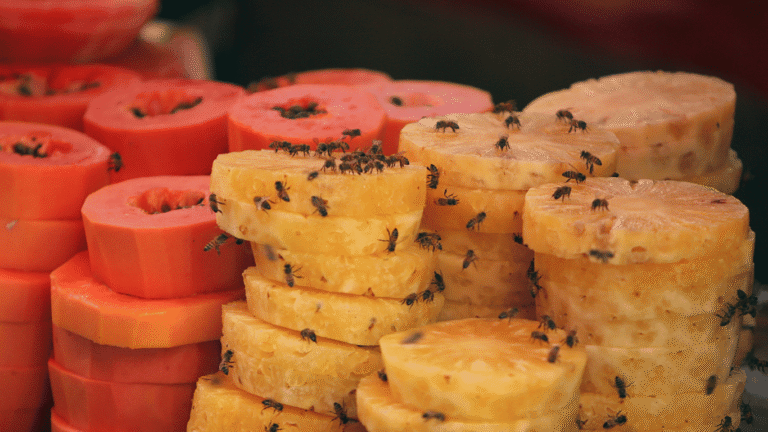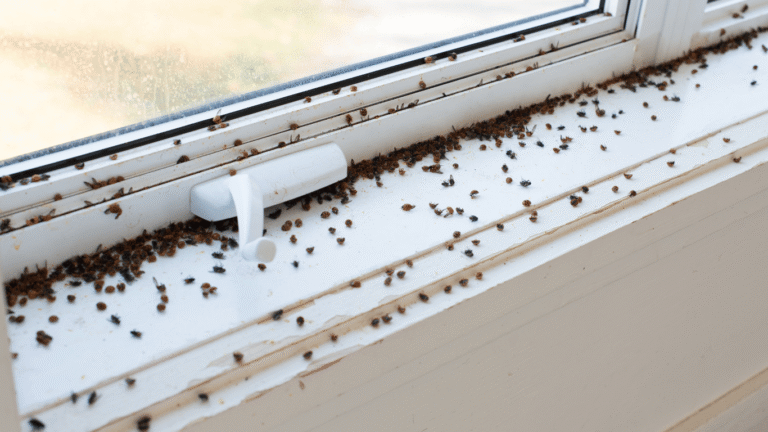
Jasper Pasion
House Fly Invasion? Here’s How to Get Rid of House Flies Easily
House Flies Takeover? Let’s Fix It Together
House flies might seem like a minor nuisance, but they can quickly turn your home into a buzzing, unsanitary nightmare. From landing on your food to hovering around the trash, these pests are more than just annoying—they’re potential health hazards.
So why are flies so relentless, and why does it feel like they always find their way back no matter what you do?
The truth is, flies and other pests aren’t just an irritation; they carry bacteria, lay eggs at lightning speed, and can infest your home in days if left unchecked. But don’t worry—you’re about to learn exactly how to eliminate them. This guide gives you clear, actionable strategies for immediate relief and long-term fly control. Let’s get started.
What Makes Flies a Pest
Life Cycle and Reproduction Rate

One reason fly control is challenging is the rapid reproduction of house flies. A single female can lay up to 500 eggs in her lifetime, often in batches of 75–150. Under warm conditions, these eggs can hatch within 24 hours. In just 7 to 10 days, the larvae (maggots) become fully adult flies, ready to repeat the cycle.
That’s why even a small fly can quickly become a large infestation if not addressed fast.
Common Species of flies that invade our homes. Here’s a list of the most frequent culprits:
| Fly Species | Description | Attracted to | Health Risks |
| House Fly (Musca domestica) | The most common type of fly found in homes is recognized by its grayish body and four dark stripes on the thorax. | Food, waste, and decaying organic matter | Can spread diseases like E. coli, Salmonella, and dysentery by contaminating food surfaces |
| Fruit Fly (Drosophila melanogaster) | Tiny, often reddish-brown flies that are especially attracted to fermenting fruits and vegetables. | Overripe or rotting fruits, vegetables, and sugary liquids. | Though not disease carriers, they can spoil food and create a nuisance. |
| Drain Fly (Psychoda spp.) | Small, fuzzy, moth-like flies that often appear near sinks, drains, and sewage systems. | Decaying organic matter in drains, pipes, and moist areas | Can cause minor contamination of food surfaces and are annoying, especially in bathrooms and kitchens |
| Blow Fly (Calliphoridae) | Often metallic in color, these flies are larger and are usually seen buzzing around decaying meat or animal carcasses | Decaying meat, garbage, or pet waste | Known for carrying pathogens like Salmonella, which can cause foodborne illnesses |
| Flesh Fly (Sarcophagidae) | Similar to blow flies but typically gray and less shiny, these flies often lay their eggs on decaying flesh | Meat or decaying animal matter | Can transmit diseases and are more commonly found near trash or improperly disposed of food waste |
| Cluster Fly (Pollenia spp.) | Larger than house flies, with a dark gray or black body, they often form clusters on windowsills | Homes during colder months, particularly near cracks and crevices, for overwintering | Although not typically dangerous, they can leave a mess in the home and create an infestation in large numbers |
| Stable Fly (Stomoxys calcitrans) | Similar in appearance to house flies, but with a piercing mouthpart that they use to bite animals and humans | Animal waste, manure, and decomposing plant material | Stable flies can transmit diseases like anthrax and equine infectious anemia, and cause irritation with their bites |
Entry Points

House flies usually enter through:
- Open doors and windows
- Gaps around window screens
- Cracks and crevices in walls or vents
Health Risks
Flies can carry over 100 pathogens, including E. coli, Salmonella, and even typhoid fever. As they move between garbage, animal waste, and your kitchen counter, they contaminate everything they touch. They don’t bite, but they vomit and defecate wherever they land.
Immediate Fly Problem Remedy
Clean Up Food Sources
Your first line of defense is cleanliness. Wipe countertops, clean spills immediately, and store fruits and leftovers in sealed containers. Don’t leave dirty dishes out overnight, and empty indoor trash bins regularly.
Vinegar and Dish Soap
Use a simple mix of apple cider vinegar and dish soap in a bowl to lure and trap flies. Flies are drawn to the smell, but the soap breaks surface tension and traps them.
Fly Traps and Fly Paper
Several types of traps can help you get quick results:
- Fly Paper: This comes in various sizes, from small to larger sheets. Oftentimes, flies are attracted to light. For best results, hang near light sources or place near the areas where flies commonly gather. Once the fly paper is full, remove it carefully to avoid the sticky surface coming in contact with your hands or the surrounding areas. Wrap the used fly paper in a plastic bag and throw it away. Be sure to wash your hands after handling it. Keep it away from pets or children to avoid accidents with the sticky surface.
- UV light traps: These attract and zap flies silently. Great for kitchens or patios.
Effective House Fly Control Tips
Keep flies from entering your home by:
- Keeping doors and windows closed, especially at dusk.
- Installing fine-mesh screens over windows and vents.
- Use door sweeps or sealing gaps around doors and baseboards.
Medium-Term Prevention Strategies
1. Deep Clean High-Risk Areas
Some fly breeding grounds are hidden:
- Clean kitchen and bathroom drains with baking soda + vinegar or enzymatic cleaners.
- Disinfect trash bins and pet bowls regularly.
- Don’t forget spots like under your fridge or inside cabinets.
2. Natural Remedies

House flies hate certain scents. Try these natural fly repellents:
- Basil, mint, or lavender plants on windowsills
- Clove-studded citrus or eucalyptus oil diffusers
- Cotton balls soaked in peppermint oil near entryways
These aren’t just chemical-free—they also freshen your home with a relaxing scent.
3. Food Storage Habits
Use airtight containers for pantry items. Avoid leaving fruit out to ripen if you have a fly issue. Keep pet food covered when not in use.
4. Use Safe Indoor Sprays
Opt for non-toxic sprays labeled for indoor use. Pyrethrin-based sprays work quickly, but ventilate the area afterward. Avoid overuse—sprays are a temporary fix, not a solution.
Get Rid of Fly Infestation Permanently
Install Permanent Barriers
If flies are a regular issue:
- Invest in high-quality mesh screens for all windows and vents.
- Install self-closing door hinges or magnetic screen doors to limit entry.
Garbage Can and Waste Management

If your kitchen smells like dinner or your garbage cans haven’t been removed, you’ve probably rolled out the welcome mat. Here are some of the tips to keep your garbage free from pesky flies :
Inside Your Home
- Use trash cans with lids
- Empty bins daily
Outside of Your Home
- Keep garbage away from doors/windows
- Rinse bins regularly to eliminate residue
Yard and Garden Maintenance
- Remove standing water—birdbaths, planters, or clogged gutters
- Don’t leave compost uncovered
- Clean up pet waste daily
Flies breed outdoors before they come in. Treat the source, not just the symptoms.
Control Moisture and Leaks
Fix leaky faucets, damp basements, or under-sink moisture. Flies thrive in humid environments and lay eggs in wet waste. Dehumidifiers can help in problematic rooms.
What Not to Do
1. Don’t Rely on One Trap Alone
Sticky traps and fly swatters may help repel flies, but they won’t solve an infestation. Apple cider vinegar and dish soap provide only temporary relief. For lasting results, a multi-method pest control approach is necessary..
2. Don’t Ignore Breeding Sites
Killing visible flies won’t help if maggots are growing in your trash or drains. Locate and eliminate all breeding grounds.
3. Don’t Overuse Chemical Sprays
They provide temporary relief but don’t address the root cause. Overuse may also create resistance and expose your family to harmful residues. For lasting results, it’s best to get rid of flies naturally.
4. Don’t Wait It Out
Thinking that a few flies will just disappear on their own is a mistake. One female can lay hundreds of eggs—and that’s a disaster waiting to happen.
Let the Pros Handle Fly Control
When it comes to getting rid of house flies, you might be tempted to try a few DIY pest control methods, like using fly swatters, sticky traps, or vinegar traps. While these can provide some temporary relief, they don’t always solve the bigger issue.
That’s where professional cleaning services come in. Experts have the tools, knowledge, and experience to tackle the root causes of your fly problem. They know exactly where flies are likely breeding and can get in there to eliminate those spots. Plus, professionals use non-toxic, effective cleaning products that won’t harm your family or pets, while also keeping your home fresh.
While DIY pest control methods can help in a pinch, professional cleaners can take the stress off your hands and provide more lasting solutions. They’ll not only clean up the mess flies leave behind, but they’ll also help prevent future infestations by sealing entry points and giving your home a thorough, fly-free makeover.
So, if you’re tired of trying to handle the fly situation yourself, why not leave it to the pros? They’ll handle everything, so you can sit back, relax, and enjoy a fly-free home.
Time to Take Back Your Space
House flies may seem small, but their impact is anything but. They spread bacteria, reproduce rapidly, and can make your home feel unbearable. Fortunately, with the right combination of immediate action, mid-term cleaning habits, and long-term prevention with the help of professional cleaners, you can win the battle.
Say goodbye to house flies and take control of your space. Ready to reclaim your home? Start with one method today, and if you need expert help, contact us! Don’t forget to share this guide with anyone else dealing with the same issue.



